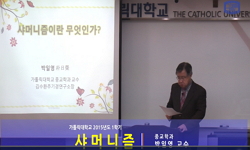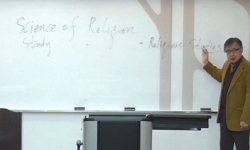Kim Hyo-kyung, a figure in the era of Japanese occupation, early on delved into Japanese religious studies and conducted research on Korean religions. In recent years, the publication of three volumes of Kim Hyo-kyung's works has significantly lowered...
http://chineseinput.net/에서 pinyin(병음)방식으로 중국어를 변환할 수 있습니다.
변환된 중국어를 복사하여 사용하시면 됩니다.
- 中文 을 입력하시려면 zhongwen을 입력하시고 space를누르시면됩니다.
- 北京 을 입력하시려면 beijing을 입력하시고 space를 누르시면 됩니다.

김효경 연구를 위한 예비적 검토: 연구이력과 독서목록을 중심으로 = Preliminary Review for the Study on Kim Hyo-kyung: Focusing on the Changes in Research Topics and Reading Lists
한글로보기https://www.riss.kr/link?id=A109044575
- 저자
- 발행기관
- 학술지명
- 권호사항
-
발행연도
2024
-
작성언어
-
-
주제어
김효경 ; 종교학 ; 민속학 ; 샤머니즘 ; 다이쇼대학 ; 한국종교 ; Kim Hyo-kyung ; 金孝敬 ; folklore studies ; shamanism ; Taisho University ; Korean religion
-
KDC
200
-
등재정보
KCI등재
-
자료형태
학술저널
-
수록면
1-94(94쪽)
- 제공처
-
0
상세조회 -
0
다운로드
부가정보
다국어 초록 (Multilingual Abstract)
The main discussion is divided into three parts - changes in research topics, post-graduation career, and the nature of scholarship seen through the reading list - aiming to scrutinize the trajectory of Kim Hyo-kyung's research activities.
The narrative outlines Kim Hyo-kyung's engagement with religious studies at Taisho University, including his enthusiastic pursuit of shamanistic studies, substantial funding-supported Fengshui research (1935~1936), a hiatus in 1937, and a subsequent shift to enlightening studies on China and Southeast Asia post the Second Sino-Japanese War. Additionally, he served as an instructor at overseas Shinto academies (1938~) and lectured at Manchurian courses and Taisho University (1940~).
To comprehensively evaluate Kim Hyo-kyung's scholarship, future research must include a comparative review with contemporaneous scholars of Korean religions. The provided reading list serves as a starting point for such investigations.
Kim Hyo-kyung, a figure in the era of Japanese occupation, early on delved into Japanese religious studies and conducted research on Korean religions. In recent years, the publication of three volumes of Kim Hyo-kyung's works has significantly lowered the threshold for research, allowing a glimpse into his life and scholarly contributions. Despite this progress, the analysis of the substantial volume of texts he produced has been relatively lacking. Acknowledging this situation, this paper focuses on preliminary tasks for future research by organizing ‘facts’ about Kim Hyo-kyung, including his background, a list of works, and reading materials. The process of reading his works revealed interconnected fragments of information, unveiling meaningful patterns or providing clues for new interpretations.
The main discussion is divided into three parts - changes in research topics, post-graduation career, and the nature of scholarship seen through the reading list - aiming to scrutinize the trajectory of Kim Hyo-kyung's research activities.
The narrative outlines Kim Hyo-kyung's engagement with religious studies at Taisho University, including his enthusiastic pursuit of shamanistic studies, substantial funding-supported Fengshui research (1935~1936), a hiatus in 1937, and a subsequent shift to enlightening studies on China and Southeast Asia post the Second Sino-Japanese War. Additionally, he served as an instructor at overseas Shinto academies (1938~) and lectured at Manchurian courses and Taisho University (1940~).
To comprehensively evaluate Kim Hyo-kyung's scholarship, future research must include a comparative review with contemporaneous scholars of Korean religions. The provided reading list serves as a starting point for such investigations.
동일학술지(권/호) 다른 논문
-
- 종교문화비평학회
- 박병훈 ( Park Byoung Hoon )
- 2024
- KCI등재
-
특집논문3 무당이즘, 점복, 의례: 김효경 무속 연구의 주제들
- 종교문화비평학회
- 한승훈 ( Han Seung Hoon )
- 2024
- KCI등재
-
- 종교문화비평학회
- 김지현 ( Kim Ji Hyun )
- 2024
- KCI등재
-
1930년대 김효경의 조선 풍수신앙 연구에 관한 비평적 검토
- 종교문화비평학회
- 이대화 ( Lee Dae Hwa )
- 2024
- KCI등재




 KISS
KISS






